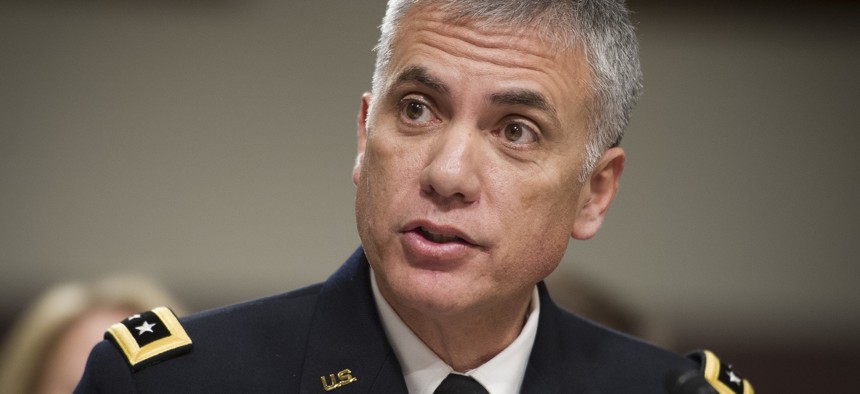CYBERCOM Chief Nominee Plans Recommendation on NSA Split Within Three Months

Army Lieutenant General Paul Nakasone Cliff Owen/AP
Lt. Gen. Paul Nakasone has “no predisposed opinion” about the split, he told lawmakers.
President Donald Trump’s pick to lead U.S. Cyber Command plans to deliver a recommendation about whether the command is ready to split form its dual hat relationship with the National Security Agency within 90 days of being confirmed, Lt. Gen. Paul Nakasone told lawmakers Thursday.
Nakasone has “no predisposed opinion,” however, about whether CYBERCOM is ready to fly solo, he told members of the Senate Armed Services Committee during his confirmation hearing.
If confirmed, Nakasone will be CYBERCOM’s third leader since the command was established in 2010 and the first to lead the outfit as a full unified combatant command. CYBERCOM was previously slotted beneath U.S. Strategic Command, though outgoing chief, Adm. Michael Rogers, said he frequently worked directly with Pentagon leadership rather than working through STRATCOM.
Trump directed Defense Secretary Jim Mattis to consider splitting NSA and CYBERCOM in connection with that elevation, but the Pentagon has not yet settled on a plan for that split or its timing.
Proponents of the split worry that the two organizations necessarily work at cross purposes from each other, especially when it comes to exposing known vulnerabilities in software.
For CYBERCOM, which is responsible for securing the military’s digital infrastructure, it will almost always be preferable to expose and patch vulnerable systems that could make the military less secure. For NSA, which relies on undisclosed vulnerabilities in commercial software to spy on U.S. adversaries, there is a great incentive to not to notify companies.
There are also reputational concerns about the country’s military and spying operations being too closely linked, advocates of the split say.
Skeptics of the split, however, worry CYBERCOM isn’t ready yet to stand on its own without NSA’s longer history and greater expertise.
Even if the dual-hat relationship is terminated, Nakasone will aim to maintain “an exceptionally close and collaborative relationship” between NSA and CYBERCOM, which he described as “the foundation of our success.”
Those comments came in response to written questions from lawmakers, which were also released Thursday.
Nakasone rejected a written question about whether NSA’s and CYBERCOM’s differing missions compromised a dual-hatted leader.
“My experience is that the dual-hat arrangement has enabled the operationally close partnership between USCYBERCOM and the NSA, which benefits both in the accomplishment of their respective missions,” he wrote.
He added that a premature split risks dangerously slowing down cyber operations.
CYBERCOM is scheduled to reach its full operating capability of about 6,200 troops across the four military services by June, Rogers told lawmakers during a separate hearing Tuesday. Nakasone confirmed that timeline in written comments Thursday.
Tight-lipped on Russia Retaliation
Nakasone was tight-lipped during his confirmation hearing about CYBERCOM’s plans to retaliate against Russia for its digital meddling in the 2016 election, largely deferring those questions to Rogers.
CYBERCOM has developed specific plans of digital attack against some U.S. adversaries that the command can present as options to civilian leadership upon request, Nakasone acknowledged.
The command has also identified adversaries’ most sensitive and vulnerable digital information, he said, but he declined to name which nations the command has focused on or to describe those plans in any detail.
If confirmed, Nakasone said, developing cyber battle plan options against Russia would be an early priority.
For his part, Rogers told lawmakers Tuesday that the White House has not explicitly ordered him to retaliate against Russia. Rogers and Nakasone both stressed, however, that cyber retaliation is not always the wisest response to a cyber strike.
‘They Don’t Fear Us’
Nakasone also echoed Rogers by noting that the U.S. has not generally deterred cyber adversaries from launching digital attacks against it and has not made clear that those attacks will invite consequences.
“I would say right now they do not think that much would happen … They don’t fear us” he said when asked if adversaries feared U.S. retaliation for cyber strikes.
One danger of that, he said, is that U.S. inaction allows nations that are more belligerent in cyberspace, such as Russia, China, Iran and North Korea to set the global norms that will define how other nations act in the future.
In a written response, Nakasone described Russia as the U.S.’s “most technically advanced potential adversary in cyberspace” and fretted about Russian capability to hack into industrial control systems in the energy, transportation and industrial sectors.
Also in response to written and spoken questions, Thursday:
- Nakasone urged more U.S. research and investment into artificial intelligence and quantum computing, noting that if China or another adversary beat the U.S. to major developments in those fields it would be “a revolution in military affairs.”
- One of Nakasone’s top priorities if confirmed, he wrote, will be “assessing the state of the NSA workforce, including morale and work climate and ensuring we are employing, empowering, and retaining the best and brightest talent our nation has to offer.”
- Nakasone touted other transaction authority, or OTA, as a way to speed up CYBERCOM’s ability to rapidly buy offensive and defensive cyber capabilities.
- Lawmakers asked Nakasone in writing: “Do you agree that demonstrating to President Putin that we have the capability and will to threaten his sources of power, wealth, and support would improve our ability to deter Russia from sustaining and intensifying its ongoing campaign to manipulate the American electorate?” He replied simply: “Yes.”






